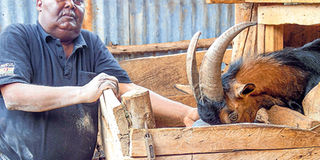Former OCS collects his weekly pension from French beans

Jackson Karani feeds goats in his farm in Mwea. He rears Alpine and Toggenburg dairy goats, a project he started in 2015. PHOTO | CAROLINE WAMBUI | NMG
What you need to know:
- Today, Mr Karani who grows French beans on 10 acres, is a happy farmer, having ploughed over Sh500,000 into agribusiness.
- Away from the crops’ farm, Mr Karani rears Alpine and Toggenburg dairy goats, a project he started in 2015 with backing from Maisha Board Self-Help Group, which he belongs to.
- He sells a mature goat at between Sh16,000 and Sh20,000, says the farmer who attends various seminars organised by the Dairy Goat Association of Kenya (DGAK) Nyeri for lessons.
- Currently, he is milking five goats out of his 25, each producing a maximum of three litres. He sells the milk at Karira Mission Hospital in Mwea at Sh150 a litre.
Some 14 kilometres from Ngurubani town in Mwea, Kirinyaga County, one finds Jackson Karani’s farm.
The farm hosts a number of crops that include French beans and animals such as goats and cows.
A former police officer, Mr Karani served in various capacities including as an OCS, before retiring in 2007.
Today, Mr Karani who grows French beans on 10 acres, is a happy farmer, having ploughed over Sh500,000 into agribusiness.
“I harvest over a tonne of French beans per acre, up to five times a week,” says Mr Karani, noting the hot and dry climate in the region has not been a hindrance as he uses furrow irrigation.
To farm the crop, Karani hires a tractor to plough the land at Sh3,000 per acre after which he makes furrows, waters the soil a day before planting and hires mainly women to plant as they maintain a spacing of 3-4 inches from plant to plant.
He then applies fertiliser, starting with DAP and CAN mixed in a ratio of 4:2 bags and then waters the crop. The plants germinate after five days.
“I apply crop-specific fertiliser at 14 weeks and when flowering starts, I spray every week to get rid of insects such as white flies and mites, and in about one-and-a-half month, the crop is ready for the market,” says Mr Karani, who sells the produce to Frigoken Limited.
He rotates French beans with maize, beans and tomatoes.
Away from the crops’ farm, Mr Karani rears Alpine and Toggenburg dairy goats, a project he started in 2015 with backing from Maisha Board Self-Help Group, which he belongs to.
The 15 members of the group took turns to purchase goats for each one of them at Sh16,000.
Mr Karani purchased four more goats and the number has risen since then, with the farmer selling 20-30 kids every year at Sh8,500 each when they are about four months.
PROPERLY VENTILATED
He sells a mature goat at between Sh16,000 and Sh20,000, says the farmer who attends various seminars organised by the Dairy Goat Association of Kenya (DGAK) Nyeri for lessons.
“The Alpines and the Toggenburg are the most preferred dairy goat breeds. They are also hardy and can adapt to virtually all agro-climatic conditions and produce to their maximum with good nutrition, proper breeding, good housing and good health management,” says Mr Karani.

Employees sort french beans at Mr Karani's Kirinyaga farm. The farmer grows French beans on 10 acres. PHOTO | CAROLINE WAMBUI | NMG
He keeps a buck that serves the does and retains it for one-and-a-half years to avoid inbreeding, before he takes it back to DGAK in Nyeri for rotation at a cost of Sh4,000.
“A good goat shed should have separate feeding and resting areas. And it should be raised two feet from the ground, should be properly ventilated, well-lit and kept neat, clean and dry as dampness attracts pests and diseases,” says Mr Karani, who uses manure from the animals on his French beans farm.
Currently, he is milking five goats out of his 25, each producing a maximum of three litres. He sells the milk at Karira Mission Hospital in Mwea at Sh150 a litre.
Mr Ephraim Nderu, the director of livestock production in Kirinyaga County, notes that farmers should use manure from the goat pens on their farms to improve the soil structure.
“This leads to improved water infiltration and greater water-holding capacity, translating to a decrease in crop water stress, soil erosion, and increased nutrient retention that results in higher crop production,” he says.
The buck’s shed, according to Mr Nderu, should measure about six-to-eight metres and that of a doe four-by-six metres so that when the doe goes on heat, it is taken to the buck.
The farmer also rears Friesian cows the initial herd of which he purchased in 2011 at a cost of Sh120,000 each. On average, he manages 25 and 20 litres of milk from the animals, selling each at Sh60 locally.
He has five workers and hires 30 -60 casuals when need arises.
“I have learnt to be patient in farming and attend regular training to boost one’s knowledge. Farming pays when done right,” he says.




